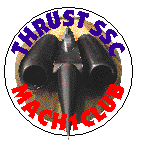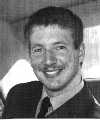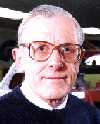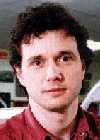
By now, most of you will have a comprehensive knowledge of the design principles behind ThrustSSC and be able to reel off some pretty impressive facts that accurately describe what it looks like and how it will perform. You will of course know all about Richard Noble, but what do you know about the other team members? Not much? - well read on, because here are some potted highlights from the CVs of some of the people who are working non-stop to complete and make sure that Andy Green has the right vehicle to get the job done and smash the Sound Barrier. We'll bring you further details of other team members in future issues. In this issue, you'll find
 Corporal Greg Tallett has RAF colleague and fellow ThrustSSC
team member John Rowles to thank for his involvement in the
project. Apart from looking after the engines and associated fuel
systems, Greg helped with the
design of the linked throttle system that will give Andy Green equal
control over both engines. He also turns his hand to many
other tasks related to building the car. With John Rowles, he's
been there since the beginning, involved with both the project
launch and some of the Tomorrow's World and Blue Peter
programmes.
Corporal Greg Tallett has RAF colleague and fellow ThrustSSC
team member John Rowles to thank for his involvement in the
project. Apart from looking after the engines and associated fuel
systems, Greg helped with the
design of the linked throttle system that will give Andy Green equal
control over both engines. He also turns his hand to many
other tasks related to building the car. With John Rowles, he's
been there since the beginning, involved with both the project
launch and some of the Tomorrow's World and Blue Peter
programmes.
Although he remembers vividly Richard Noble's runs with Thrust2 in the early '80's, record-breaking wasn't something that had grabbed his attention until approached by John. As Greg explains so succinctly, "John asked if I would be interested, since there was space for another engine man on the team. I was and here am!"
Originally from Pembury in Kent, Greg joined the RAF almost 12 years ago and after undergoing basic and trade training moved to Wattisham in October 1984 joining the Aircraft Servicing Flight working on Phantom FGR2s and F4Js. Part of his pre-employment selection training course also involved work on both variants of Phantom. The FGR2 is Spey powered, but interestingly the F4J gets its motive force fron the GE-J79-lOB as used by Craig Breedlove and Rick Kikes/Gary Swenson in their LSR contenders "Knowing something about how the opposition engines work might come in handy" says Greg. Quite right.
His time at Wattisham was broken by a tour of duty for No 23 (F) Squadron in the Falklands before moving to RAF St Athan two and a half years ago where he still works as a Propulsion Systems Engineer. Apart from the Phantom connection, Greg can list an impressive array of aircraft keeping him busy. Tornado GR1, F2, F3, Harrier GR7 and T4, Sea Harrier FRS1, Jaguar, Hawk, Tucano and Islander all fall within his remit.
When he's not busy keeping that little lot in fine fettle, Greg and his wife Kim look after daughters Jennifer and Melissa at their home in St Athan. Extending the flying connection into his private life, Greg is a Silver Badge glider pilot, but also enjoys a variety of pastimes ranging from sea angling and tropical fish-keeping through to car maintenance and home wine making - when he's got the time that is!
 Asked how he first got involved with Richard Noble on
the Thrust project, Ron Ayers' immediate tongue-in-cheek
reply was, "It was all a dreadful accident!" Happily retired,
Ron had been putting his lifetime of aerodynamic design
experience to good effect researching a theory about why
most major LSR cars over the years have always
underperformed relative to their original design
specifications. Time spent as a part-time guide at
Brooklands Museum close to his home in Claygate,
Surrey, had given Ron access to a wealth of research
papers from early record-breaking attempts, and it was
this that sparked his interest in record-breaking - hence
his 'retirement project.' From there it was a logical
progression to Ken Norris, designer of Donald
Campbell's Bluebirds. Delayed by motorway roadworks,
Ron had his "dreadful accident" when he met Richard
Noble, who was on the way out of Ken's office just as he
was arriving. What luck! - he now had access to the data
from Thrust2 as well.
Asked how he first got involved with Richard Noble on
the Thrust project, Ron Ayers' immediate tongue-in-cheek
reply was, "It was all a dreadful accident!" Happily retired,
Ron had been putting his lifetime of aerodynamic design
experience to good effect researching a theory about why
most major LSR cars over the years have always
underperformed relative to their original design
specifications. Time spent as a part-time guide at
Brooklands Museum close to his home in Claygate,
Surrey, had given Ron access to a wealth of research
papers from early record-breaking attempts, and it was
this that sparked his interest in record-breaking - hence
his 'retirement project.' From there it was a logical
progression to Ken Norris, designer of Donald
Campbell's Bluebirds. Delayed by motorway roadworks,
Ron had his "dreadful accident" when he met Richard
Noble, who was on the way out of Ken's office just as he
was arriving. What luck! - he now had access to the data
from Thrust2 as well.
Intrigued by Ron's research, Richard Noble soon discovered that here was a highly experienced aeronautical engineer who had begun work as an engineering apprentice with Handley Page. That eventually led to the design of guided missiles for what was to become British Aerospace, but clearly you don't get to do this without having a very sound educational background, so it should come as no surprise that Ron has an M Sc. from Cranfield specialising in aerodynamics, as well as a B Sc. in aero engineering from London University. He is also a Chartered Engineer and a member of the Royal Aeronautical Society. What is less well known about his background is that he also put his skills to good effect by spending ten years as a printers engineer.
Without it being his original intention, Ron soon found that his historical research had led him to being responsible for the overall aerodynamic research and design of what was to become ThrustSSC. One charming footnote to the story is a letter Ron received from one R H Beauchamp who began his working life as assistant to that great record-breaker Parry Thomas and ended up as Chief Designer at Thompson & Taylor at Brooklands during the great days of Segrave, Campbell and Cobb. Even though well into his nineties, he was still able to make positive suggestions about how to design a supersonic car.
Although the aerodynamic work is largely completed by now, there is still some detailed work to do plus a variety of research in other areas, not to mention the heavy schedule of lectures and press and promotional activities. At one lecture, Ron was most unusually struck dumb for a while when a member of the audience expressed surprise and disappointment that we were not trying to exceed the speed of light! Ermmm...
When the car first runs, it will be as Ron explains, "a research vehicle before it ever becomes a record-breaking vehicle", so any thoughts of relaxing during his retirement are firmly out of the window for the time being. Widowed a few years back, he has one grown-up son and spends what little spare time he has tending his large garden out of necessity rather than pure enjoyment" as he puts it, and "dabbling" at bridge and golf.
 For somebody who professes to be "not that interested in
record-breaking as such", Jeremy Bliss has been making
a major difference to the achievement of exactly that
since joining the team in February 1995. For the last 15
months, he's worked for Ford's Dunton based Research &
Engineering outfit as part of a team that delights in the
name, TAMSE (thermal & aerodynamic management
systems engineering).
For somebody who professes to be "not that interested in
record-breaking as such", Jeremy Bliss has been making
a major difference to the achievement of exactly that
since joining the team in February 1995. For the last 15
months, he's worked for Ford's Dunton based Research &
Engineering outfit as part of a team that delights in the
name, TAMSE (thermal & aerodynamic management
systems engineering).
So if he was not that interested in recordbreakingl then why is he doing it? Well, after getting a degree in Aeronautical Engineering, he joined Lotus Engineering working on vehicle aerodynamics, but moved over to help develop active suspension systems which involve hydraulics, electronics, suspension dynamics and programming the infamous 'black boxes' in Assemble, Basic and 'C'. Remember that this was in the days when the likes of Senna and Mansell were at Lotus with the 99T, before the marque slid down the Fl Iadder to oblivion.
While talking to John Davis, an old boss of his one day, he was musing aloud on how his active suspension experience was not being used to good effect. John knew of the Thrust project and knew there would a chance for somebody with Jeremy's skills to get involved. As Jeremy says, "fairly predictably, I said - Yes". He continues, "three weeks later Ron Ayers called me and we arranged to meet at his house to have a chat about things. I arrived at eight in the evening and left after midnight and have been involved ever since!"
This was fortunate for all concerned since many of Jeremy's skills can be applied to areas covered by Andy Day, whose time on the project is now severely limited by the demands of his work with the RAF. Apart from the design of the hydraulic system for the active ride, Jeremy is also working on the instrument panel, installation of the data system and transducers, co-ordination of the current vehicle systems and help with the design of a variety of other components.
Born in Accra, Ghana, Jeremy enjoys village life at Ramsden Bellhouse in Essex, although he also has a house in Norwich. Interests in paragliding, sailboats and motorbikes are matched equally by a love of Jameson's Irish Whisky and support for the Greenpeace environmental movement. "I believe strongly in environmental protection," says Jeremy, "although my views are pragmatic in that I believe that we must live within the means of the planet and reduce our impact on it to a minimum in order to maintain our current lifestyle." With that in mind, he is exploring the possibility of using solar cells to power the hydrocarbon refrigerant charged airconditioning unit that will cool both driver and electrical system during Thrust SSC's turnaround period on the desert.
So, back to the question, why is he doing it? Jeremy explains, " Sometimes I help friends with Formula Ford racing although in general, as with worlds records, I find the technical challenge of doing things that haven't been done before more exciting than the fact that it's motor sport. To me, this project is a massive adventure and a huge leap into the unknown and surely there are few people who wouldn't find that exciting. If you have to ask the question why, then you will probably not understand the answer."
 The sleek exterior of ThrustSSC hides a veritable
maze of wiring, pipes, pumps, electronic and mechanical
components, computers, instruments and much, much
more. Making sure that these fit into Glynne's chassis,
connect all the right bits together and then actually work,
is the responsibility of the Systems Manager. That
position is now taken by Jeremy Bliss, but before he
joined the project, the initial work was carried out by Royal
Airforce systems man, Andrew Day. Unfortunately for him
in SSC project terms, the increasing demands his RAF
work means that he has now handed over that task to
Jeremy, but continues as a Systems consultant, being
brought in as and when his time allows.
The sleek exterior of ThrustSSC hides a veritable
maze of wiring, pipes, pumps, electronic and mechanical
components, computers, instruments and much, much
more. Making sure that these fit into Glynne's chassis,
connect all the right bits together and then actually work,
is the responsibility of the Systems Manager. That
position is now taken by Jeremy Bliss, but before he
joined the project, the initial work was carried out by Royal
Airforce systems man, Andrew Day. Unfortunately for him
in SSC project terms, the increasing demands his RAF
work means that he has now handed over that task to
Jeremy, but continues as a Systems consultant, being
brought in as and when his time allows.
Born in Bradford-on-Avon, Andrew now lives with his wife at Scampton near Lincoln and has been in the RAF for the past 12 years. A BSc (Hons) degree in Air Transport Engineering is put to good effect since he is now in charge of scheduled maintenance on Sentry AEW Mk1 aircraft at RAF Waddington. A lifelong motoring and motorsport enthusiast, Andy joined the RAF Motor Sports Association and was actually introduced to the Thrust project by this organisation. His motorsport interest extends to competing in the Revington TR Spares/TR Register sprint & hillclimb championship in a TR7, while back in July he organised the TR Register jubilee sprint at Boscombe Down, a location well known to many of the RAF pilots who applied for the ThrustSSc drivers position.
 |
 |
 |
||
| Sponsored by | This site best viewed with Microsoft Internet Explorer 3 | |||